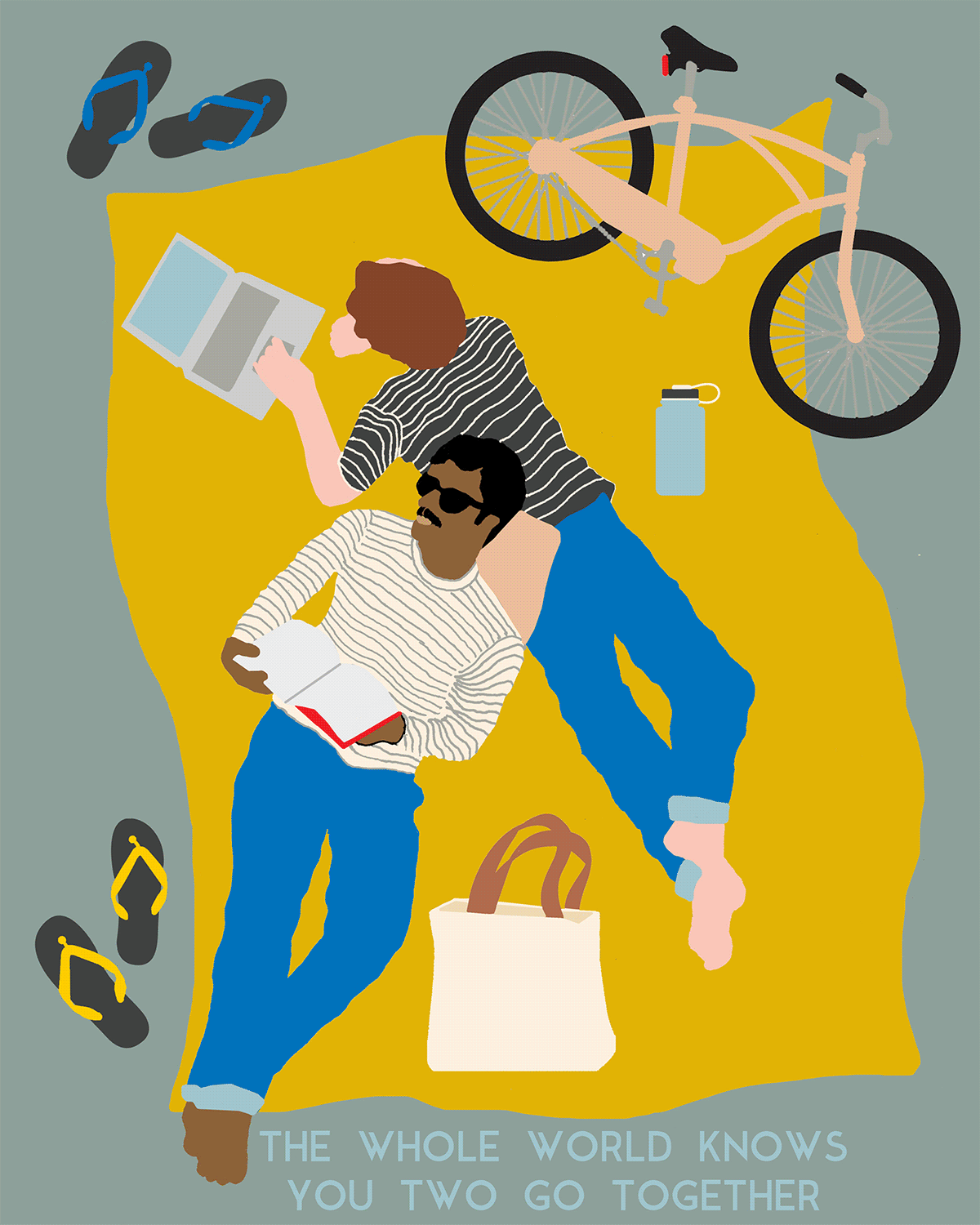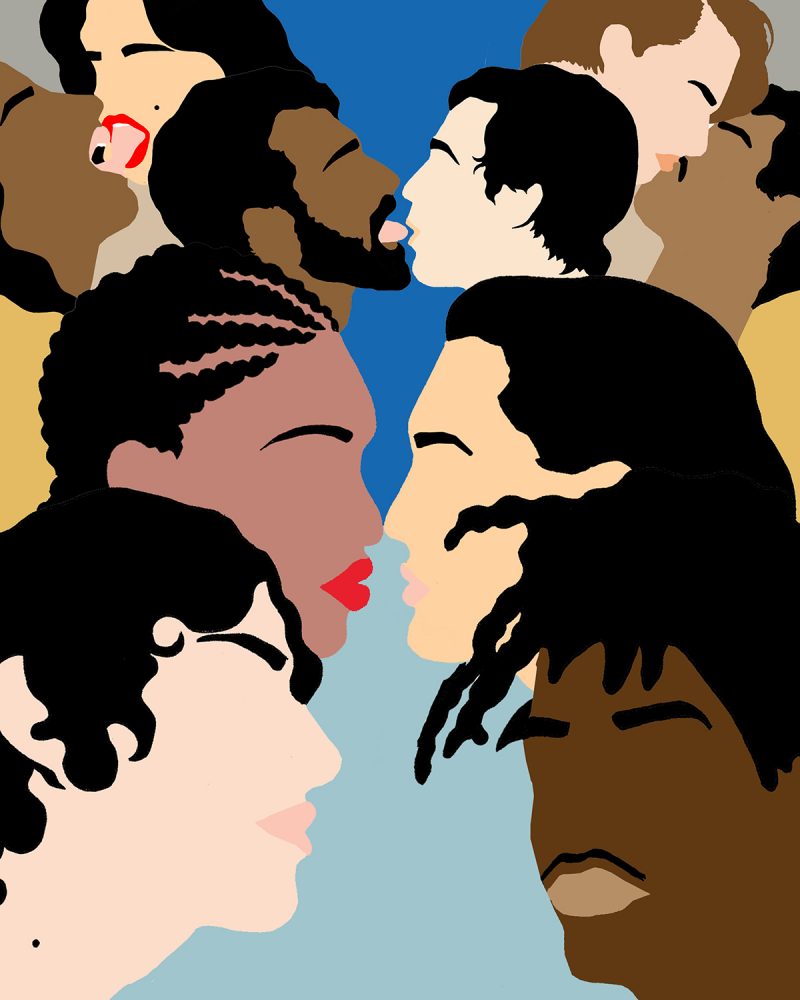
Bario Neal Teams Up With Artist Xavier Schipani To Help Us Show Why LGBTQIA Visibility Matters In the Wedding Industry
With Schipani's "Infinite Love" print, Bario Neal will donate net proceeds to Voices4. This organization's mission statement is one we can get behind: "Voices4 is a nonviolent advocacy group aimed at achieving global queer liberation. We envision a world where every queer person, regardless of where they live, will be able to fully express and embrace their identity how they choose and without fear, discrimination, or persecution of any kind. We utilize direct action to affect change, both nationally and internationally, around the treatment of queer people while building an interconnected global coalition of queer activists working to challenge the systems of power that enable and sanction queer persecution."
Our sales specialist, Taylor D'Amico, took the opportunity to interview Xavier Schipani about his work, why representation matters, how pop-culture and activism co-exist, and their experiences as trans* people shopping in traditionally gendered spaces.
Did you know that the Gay and Lesbian Alliance Against Defamation shows that more young Americans are rejecting traditional gender labels? 20% of 18-34-year-olds identify as socially fluid, queer, bisexual, or pansexual and 12% identify as transgender or gender nonconforming, all within the LGBTQIA lexicon.

As some of you can imagine, shopping for traditionally gendered things as a trans* person can not only be difficult and stressful but can be dysphoric and be embarrassing at times. Being a transgender woman myself, I, and many other trans*/queer people have experienced this situation one too many times. Anyone who doesn't fall in the cisgendered norm of Male and Female knows this feeling all too well, whether you're trans, non-binary, gender fluid, intersex, etc. For a transgender woman having to go out and buy her first bra, or a non-binary person going to a jewelry store and picking out their engagement ring, the situation can become very stressful. Specifically, in jewelry, we have to worry about things like the assumption of gender, sizing, and representation when we're doing something as special and monumental as picking out an engagement ring. Since the jewelry industry is so traditional and gendered, Bario Neal wanted to change the shopping experience for all customers.

When dealing with gender and buying traditionally gendered products like jewelry, it can feel as if everything is so black and white, and by black and white we mean "male and female." Men's categories and Women's categories are outdated and exclude gender non-conforming/non-binary people. Bario Neal focuses on describing the jewelry, not the identity of those who wear it. When products are organized into categories, Bario Neal uses more inclusive descriptions: Masculine or Feminine. Identifying men can shop in feminine, identifying women can shop in masculine, and gender non-conforming people can shop in either masculine, feminine, or gender neutral.

Same-sex couples also have many struggles when it comes to jewelry shopping, especially engagement ring shopping. Luckily, since the ruling by the U.S. Supreme Court in June of 2015 to legalize same-sex marriage in all 50 states, shopping for engagement rings as a same-sex couple in 2018 is a lot less gut-wrenching than it was in 2008, just a decade ago. 10.6% of adult same-sex couples are married, coming close to the 13.6% of adult heterosexual couples in the US who are married. Same-sex couples don't apply gender roles when searching for the perfect engagement ring, they don't have to, and neither should cisgendered heterosexual couples. Social advances and the visible inclusion of the LGBTQIA community has encouraged many cisgendered heterosexual couples to kick these gender binary "rules" to the curb as well. If you see that special piece that gives you goosebumps or makes you smile as soon as you see it - go for it!

When given the opportunity to interview Xavier Schipani, I was over the moon to have an important conversation relating to trans*, queer, and non-binary issues from two people who are actually within the community through Bario Neal's platform. Having the platform to talk about LGBTQIA inclusion from someone who's actually within the community is vital to the conversation of LGBTQIA related issues.
Taylor: Recently you collaborated with us here at Bario Neal for an upcoming campaign for Pride month, what're some of your current favorite Bario Neal pieces?
Xavier: I really love the creativity of the settings on the rings! I was looking at them specifically because my wife and I have our 2nd Wedding Anniversary coming up this month. We both have September birthdays, so I love the Nikko Pear White Sapphire ring, I had never seen a white sapphire before, our birthstone!
Taylor: Your work is such a fantastic blend of activism combined with sex and contrasts of high and low design. Who are leaders in activism and sexual expression that inspire you?
Xavier: When I think about activism it's important for me to understand the progress that has been made, what we are doing now and what needs to be done. Marsha P. Johnson is someone that comes to mind when I think of trans progress, she is what I would call my trancestor. For "Now" I am really inspired by a group called "Voices 4". They are based in New York, and they focus on amplifying the voices that are often suppressed within the LGBTQIA communities all over the world. Emma Gonzales' speech was incredible in the wake of tragedy, her voice and others from that generation give me hope for the future collective thought. I also think that this younger generation is helping create a conversation that is exciting about gender fluidity and sexuality, it's fresh and open minded and so necessary.
Taylor: In modern times, how can we make representations of sex and gender revolutionary? How can brands participate in a meaningful and sincere way, while also supporting artists like you?
Xavier: I think that it is important to be inclusive, I think that there are a lot of identities that fall through the cracks even within the LGBTQIA community and are often left out or not even considered when it comes to representation. I think that a lot of brands are taking strides to be inclusive but there is always room for growth. I think that brands should want to have as many perspectives as possible, for example if I see a brand using a trans model in a campaign I am more likely to support it because I feel supported by it.
Taylor: What have your experiences with the wedding industry been like as a trans man? Being as though shopping for traditionally gendered things, like shopping for wedding or engagement jewelry, can be a lot for LGBTQIA people. What things would you want to change in the wedding industry overall?
Xavier: I had a really enjoyable experience, I know that isn't the case for everyone however. I loved designing my wife's engagement ring, I worked with one of her friends who also happens to be queer. I think that when you are in love and you choose to celebrate that publicly, you should do what feels right and find ways to make it comfortable and special for YOU. I think the one thing I would change is the level of pressure we put on ourselves for things to be "perfect" and to make up our own traditions as we go.
Taylor: Looking through your work, you depict so many gender representations and sexual orientations. Why do you think it's important to explore this as an artist?
Being a creative artist as well as a voice within the art scene for trans/queer people, do you ever find it challenging to make art that is understandable to its audience? Or to find that certain voice/message for each of your pieces?
Xavier: I think that visibility is REALLY important, which not only means being seen by others but being represented, recognized and acknowledged in society. My point of view gives me a unique perspective and I feel passionate about sharing that through my work. Art can help us create language in a conversation that we don't quite understand or feel like an outside participant, inclusion is so important in transcending barriers put up by a binary society. Something I tell myself and others is that "I see you always, in all ways" which I shared with Bario Neal while working on this campaign. I think this message is important in terms of what it means to transition not only in gender/identity but in all aspects of life.

Taylor: You reference a lot of pop culture and politics in your artwork, is this a personal choice to pay homage to people who inspire you within the community? Or is there more of an underlying message to reflect the way society interacts with celebrities?
Xavier: I think that pop culture and politics with the help of social media have become married in a huge way, which has its ups and downs - I mean, look at our President; he is a perfect example. I definitely like to pay homage to my queer peers, transcestors and those fighting the good fight within our current tumultuous political climate. We are in an interesting time where people are truly being held accountable for their actions in a way like never before and I think artistic expression is a powerful, energetic and educational tool that creates unity for change.
Taylor: You recently did a collaboration with Refinery29's 29Rooms that features a big project of yours, what was this process like for you to work with Refinery29 and to have such a powerful message of queer inclusivity when dealing with bathrooms?
Being as though Pride month is officially here, do you have any upcoming projects that you're excited to share that you can tell us about?
Xavier: 29rooms will be in San Francisco for pride in a couple weeks and then the show will continue on to Chicago in July.
Collaborating on "Gender Neutral" room was important for me as a part of the LGBTQ community and it was an honor. The "bathroom" as a physical space holds a great range of meaning to different identities. For many of my peers it is a place where anxiety and fear holds them captive when they feel most vulnerable. This installation was about visibly telling a gender story of inclusion and a representation of bodies that are often seen only in turmoil. It is about creating a safe space.
Creating a safe space for someone to be in means more than telling them that it is safe, you have to show them that it is. Working with Refinery29 on this was amazing, they have such a great team and an amazing platform. They are a huge catalyst for the LGBTQIA community in terms of visibility and continue to show an incredible amount of support through education, storytelling and coverage within the community.
I have an upcoming solo show in that opens in June at the Lora Reynolds Gallery in Austin, TX. The show will be a combination of paintings and installation and is a commentary on the "fall of man" and toxic masculinity! I just finished working on LadyLand, a new queer festival that will take place during NYC pride, doing all of the branding! So June will be a very PRIDE-FULL month for me!
Be sure to follow Xavier to stay updated on all his upcoming and exciting projects here: